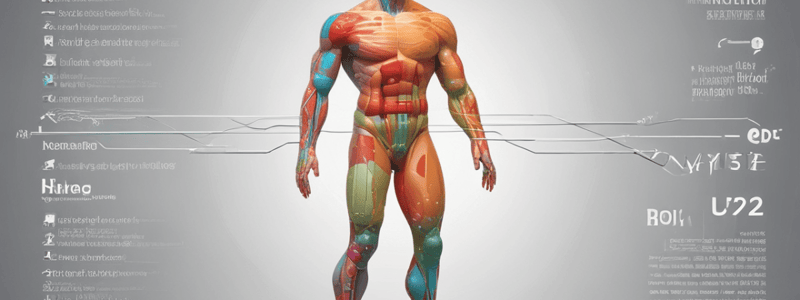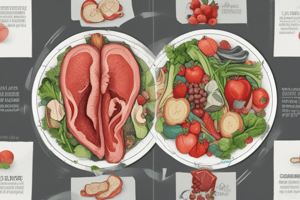Podcast
Questions and Answers
What is the primary function of leptin in regulating adiposity?
What is the primary function of leptin in regulating adiposity?
- To act as a negative feedback regulator of adiposity (correct)
- To decrease the metabolic rate and conserve energy
- To stimulate appetite and increase energy intake
- To increase glucose uptake in adipose tissue
What is the term for the number of calories burned by the human body in one day?
What is the term for the number of calories burned by the human body in one day?
- Basal Metabolic Rate
- Thermic Effect of Food
- Total Energy Expenditure (correct)
- Activity Energy Expenditure
What percentage of Total Energy Expenditure is accounted for by Resting Energy Expenditure?
What percentage of Total Energy Expenditure is accounted for by Resting Energy Expenditure?
- 40-50%
- 60-70%
- 10-20%
- 20-30% (correct)
Which of the following is a consequence of leptin resistance?
Which of the following is a consequence of leptin resistance?
What is the term for the energy released when the subject is at complete mental and physical rest?
What is the term for the energy released when the subject is at complete mental and physical rest?
What is the primary factor that contributes to the development of overeating and obesity?
What is the primary factor that contributes to the development of overeating and obesity?
What is the percentage of Total Energy Expenditure accounted for by Activity Energy Expenditure?
What is the percentage of Total Energy Expenditure accounted for by Activity Energy Expenditure?
What is the term for the process by which the body regulates energy intake and expenditure to maintain energy homeostasis?
What is the term for the process by which the body regulates energy intake and expenditure to maintain energy homeostasis?
Which of the following activities would have the lowest energy expenditure?
Which of the following activities would have the lowest energy expenditure?
What is the term used to express the energy cost of physical activities as a multiple of Basal Metabolic Rate (BMR)?
What is the term used to express the energy cost of physical activities as a multiple of Basal Metabolic Rate (BMR)?
What is the approximate range of PAR for sedentary activities?
What is the approximate range of PAR for sedentary activities?
Which of the following is NOT a factor that contributes to Total Energy Expenditure (TEE)?
Which of the following is NOT a factor that contributes to Total Energy Expenditure (TEE)?
What does the term 'PAL' represent?
What does the term 'PAL' represent?
According to the passage, what is the approximate TEE for a person engaged in sedentary or light activity, expressed in MJ?
According to the passage, what is the approximate TEE for a person engaged in sedentary or light activity, expressed in MJ?
Which of the following is an example of a catabolic reaction?
Which of the following is an example of a catabolic reaction?
Which of the following metabolic substrates is NOT a primary energy source for the body?
Which of the following metabolic substrates is NOT a primary energy source for the body?
What is the main difference between Basal Metabolic Rate (BMR) and Resting Metabolic Rate (RMR)?
What is the main difference between Basal Metabolic Rate (BMR) and Resting Metabolic Rate (RMR)?
Which organ accounts for the highest percentage of Resting Energy Expenditure (REE)?
Which organ accounts for the highest percentage of Resting Energy Expenditure (REE)?
Which of the following organs contributes the least to Resting Energy Expenditure on a weight basis?
Which of the following organs contributes the least to Resting Energy Expenditure on a weight basis?
In the context of energy metabolism, what does TEF stand for?
In the context of energy metabolism, what does TEF stand for?
How does the energy expenditure of muscle tissue at rest compare to that of the heart?
How does the energy expenditure of muscle tissue at rest compare to that of the heart?
What was the first equation used for estimating energy expenditure?
What was the first equation used for estimating energy expenditure?
What percentage of Resting Energy Expenditure is contributed by the brain?
What percentage of Resting Energy Expenditure is contributed by the brain?
Which of the following statements about energy metabolism is inaccurate?
Which of the following statements about energy metabolism is inaccurate?
Flashcards are hidden until you start studying
Study Notes
Energy Metabolism
- BMR (Basal Metabolic Rate) is the minimum number of calories required for basic functions at rest.
Resting Energy Expenditure vs BMR
- Resting Energy Expenditure (REE) is also called Resting Metabolic Rate (RMR).
- REE is the number of calories required for basic functions at rest, plus energy for organs with high energy needs.
- Organs with high energy needs (5% of body weight) use 58% of REE:
- Liver: 21% of total REE
- Brain: 20% of total REE
- Heart: 9% of total REE
- Kidneys: 8% of total REE
- Muscle Energy Expenditure (EE) is only 3% of heart's EE/g at rest, but comprises 22% of RMR at rest.
- Adipose tissue has a lower EE/g and is always at rest:
- 4% of RMR in lean individuals
- Up to 10% of RMR in obese individuals
Estimating BMR and REE
- Several equations can be used to estimate energy expenditure, including the Harris-Benedict equation and the Institute of Medicine Equation for Estimated Energy Requirement (EER).
Thermic Effect of Food (TEF)
- TEF is the energy cost of digestion, absorption, processing, and storage of nutrients.
Physical Activity in Energy Expenditure
- The rate of energy expenditure ranges from low-energy activities (e.g., sleep) to high-energy activities (e.g., sprinting).
- Physical activity includes movement of at least light intensity, extending to moderate and vigorous intensity.
Energy Requirements Increase With Activity
- The energy cost of physical activities is expressed as a multiple of BMR, known as the physical activity ratio (PAR) or metabolic equivalent of the task (MET).
- Sedentary activities use about 1.1 to 1.2 × BMR, while vigorous activities use 6 to 8 × BMR.
- Overall physical activity level (PAL) is the sum of the PAR of different activities.
Energy Balance and Regulation
- Leptin, a hormone secreted by adipocytes, acts as a negative feedback regulator of adiposity via leptin receptors in the hypothalamus.
- Leptin resistance may contribute to overeating and obesity.
- Reward signals, such as palatability and energy density, can contribute to overeating and obesity.
- Homeostatic regulation of food intake involves the balance of energy expenditure and intake.
Energy Balance – Energy Expenditure
- Total Energy Expenditure (TEE) is the number of calories burned by the human body in one day.
- TEE is composed of three primary factors:
- Resting Energy Expenditure or basal metabolic rate (60-70%)
- Thermic effect of food (10-30%)
- Activity (20-30%)
Studying That Suits You
Use AI to generate personalized quizzes and flashcards to suit your learning preferences.




